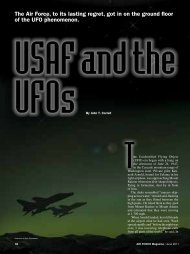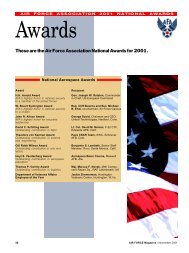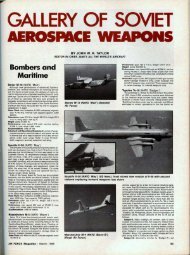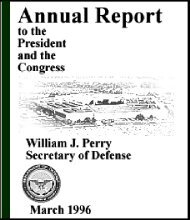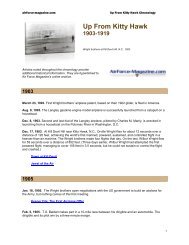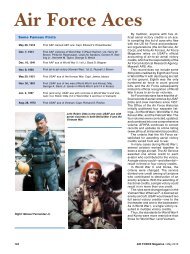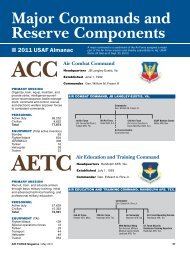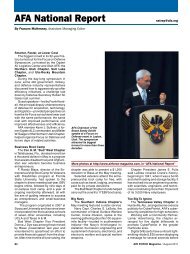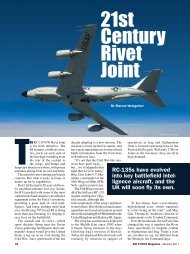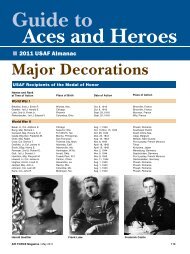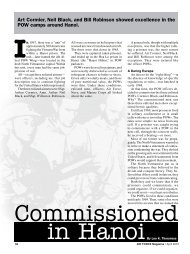0701crash - Air Force Magazine
0701crash - Air Force Magazine
0701crash - Air Force Magazine
You also want an ePaper? Increase the reach of your titles
YUMPU automatically turns print PDFs into web optimized ePapers that Google loves.
From the U-2 to the F-117A, it’s a dicey issue deciding what<br />
to say and do when classified airplanes go down.<br />
When Secrets Crash<br />
WHEN a passenger airliner<br />
crashes, investigators from<br />
the National Transportation<br />
Safety Board quickly arrive on<br />
the scene to try to determine what<br />
went wrong. Press conferences and<br />
press coverage follow. The NTSB<br />
Web site notes that media are briefed<br />
at least once a day by one of the<br />
board members accompanying the<br />
investigating team and that a public<br />
affairs officer maintains contact with<br />
the media. Viewers of the nightly<br />
news often see aerial images of the<br />
crash site. The flight and airplane<br />
involved will be precisely identified<br />
by the airline and NTSB. Eventually,<br />
the public can expect a detailed<br />
report on the conclusions.<br />
Things can be very different when<br />
the crash involves a military aircraft—particularly<br />
if it is an airplane<br />
whose existence or mission the<br />
United States has not yet acknowledged<br />
or that carries particularly<br />
58<br />
sensitive equipment. Over the years,<br />
a variety of secret intelligence and<br />
military aircraft have crashed, and<br />
the specifics of US government responses<br />
have varied—sometimes as<br />
the result of the different circumstances<br />
of the crashes, other times as<br />
the result of different rules for dealing<br />
with the press queries concerning<br />
classified programs. However,<br />
preserving secrecy has been a constant<br />
objective.<br />
Often times, details of the crash<br />
and investigation will emerge only<br />
many years later, after the existence<br />
and mission of the aircraft have been<br />
acknowledged and documents have<br />
been released in response to Freedom<br />
of Information Act requests or<br />
as a result of government declassification<br />
programs. The U-2, A-12<br />
Oxcart, SR-71A, and F-117A all are<br />
aircraft whose existence was at one<br />
time a tightly held secret but which<br />
suffered crashes.<br />
Spyplane on Display<br />
By September 1959, the U-2 had<br />
been flying operational missions for<br />
more than three years. It had survived<br />
Soviet attempts to knock it out<br />
of the sky with surface-to-air missiles<br />
and MiGs. At the time, of course,<br />
its espionage mission was an unacknowledged<br />
one. It was, the US government<br />
declared, an airplane used<br />
for high altitude weather research<br />
and was operated by “weather reconnaissance”<br />
squadrons. It was a<br />
cover story that few believed; in May<br />
1957, the London Daily Express<br />
wrote of the U-2’s espionage missions<br />
behind the Iron Curtain. However,<br />
weather reconnaissance was<br />
Washington’s story, and it was sticking<br />
with it.<br />
One of the weather reconnaissance<br />
squadrons, whose covert designation<br />
was Det. C, was located at the US<br />
naval air station at Atsugi, Japan.<br />
Since 1957 that detachment had been<br />
AIR FORCE <strong>Magazine</strong> / July 2001<br />
flying missions over the USSR and<br />
China, photographing the Klyuchi<br />
ICBM test area in June 1957 and<br />
monitoring Chinese troop movements<br />
in the fall of 1958. By fall 1959,<br />
despite flying some actual weather<br />
reconnaissance missions in an attempt<br />
to add credibility to its cover,<br />
political problems were beginning<br />
to inhibit U-2 operations. Those operations<br />
were difficult to conceal.<br />
Atsugi was a busy airbase, with a<br />
variety of Japanese military and civilians<br />
on the base. US military deployments<br />
and movements in Japan<br />
were followed closely by outside<br />
observers.<br />
On Sept. 24, 1959, Thomas L. Crull<br />
was flying a newly arrived U-2C,<br />
Article 360, on a local flight, heading<br />
back to Atsugi after setting an<br />
altitude record. As the U-2’s fuel ran<br />
low, the airplane suffered a flameout—forcing<br />
Crull to make a deadstick,<br />
wheels-up landing at the Fuji-<br />
By Jeffrey T. Richelson<br />
In 1959 when this U-2 suddenly lost<br />
power, the pilot, a major from Taiwan<br />
in training to overfly China, was able<br />
to glide in and land at a small airfield<br />
in Colorado. A very short wire<br />
service article only described the<br />
pilot as an <strong>Air</strong> <strong>Force</strong> major on a<br />
weather reconnaissance flight.<br />
sawa glider strip, 10 miles from<br />
Atsugi. Crull emerged unhurt, but<br />
his airplane overran the runway and<br />
slid onto the grass.<br />
Letting the airplane simply sit there<br />
unguarded was not an option. A short<br />
time later several security personnel,<br />
apparently wearing loud Hawaiian<br />
shirts and packing large revolvers,<br />
showed up and began to order<br />
the growing crowd at gunpoint to<br />
stand away from the secret aircraft.<br />
The tactic proved counterproductive<br />
as it only led to extensive publicity<br />
about the crash landing. Eventually,<br />
the airplane would be packed off to<br />
the US, repaired, and returned to<br />
service with Det. B in Turkey.<br />
From there, that airplane would<br />
make its final flight. It came on May<br />
1, 1960, and its pilot was Francis<br />
Gary Powers. Powers was flying high<br />
over Sverdlovsk, USSR, when his<br />
U-2 came under attack by some 14<br />
surface-to-air missiles. The U-2<br />
broke apart, but Powers parachuted<br />
down safely and was captured, given<br />
a trial, and sentenced to 10 years in<br />
a labor camp. He was freed in 1962<br />
in an exchange for the Soviet spy,<br />
Rudolf Abel.<br />
Less than a month before Powers’s<br />
fateful flight, another U-2 had made<br />
a crash landing, this time into a rice<br />
paddy in Thailand. In contrast to the<br />
Atsugi incident, the only publicity<br />
in this case was an article in a local<br />
newspaper reporting on the crash of<br />
a jet airplane. Because the area was<br />
inaccessible to large vehicles, the<br />
airplane could not simply be hauled<br />
out of the rice paddy. Instead, it had<br />
to be cut into pieces. Then, with the<br />
assistance of local villagers, those<br />
pieces were hauled by oxcart to a<br />
place where they could be loaded on<br />
trucks. One night, the trucks carried<br />
the dismembered aircraft through<br />
Bangkok to Don Muang airfield.<br />
There, it was loaded onto a C-124<br />
cargo airplane and flown back to the<br />
US. The CIA, to show its appreciation<br />
for the villagers’ efforts, provided<br />
$500 to build a new school.<br />
A Different Kind of Oxcart<br />
On May 26, 1963, the New York<br />
Times carried a front page story under<br />
the headline, “New Test Delay<br />
May Doom RS-70,” which reported<br />
that, according to authoritative<br />
sources, “the first prototype for the<br />
<strong>Air</strong> <strong>Force</strong>’s RS-70 reconnaissance<br />
bomber will not be flight-tested until<br />
September at the earliest.” Intended<br />
to fly at 2,000 mph, the airplane<br />
might not fly at all, the paper<br />
reported, as a result of the repeated<br />
delays that plagued the program.<br />
What the Times did not report, and<br />
apparently did not know, was that<br />
the CIA was already testing another<br />
reconnaissance airplane that was<br />
projected to fly at speeds greater<br />
than Mach 3, at altitudes of up to<br />
100,000 feet, and with the equipment<br />
to photograph huge expanses<br />
of territory. This airplane was the<br />
result of a 1958 decision by President<br />
Eisenhower to authorize devel-<br />
AIR FORCE <strong>Magazine</strong> / July 2001 59
Lockheed photo via Jay Miller<br />
opment of aircraft that would fly<br />
higher and far faster than the U-2 in<br />
the expectation that its speed and<br />
altitude would make it invulnerable,<br />
if not invisible, to Soviet air defenses.<br />
Nor did the paper report that<br />
one of these top secret A-12 aircraft,<br />
which had been developed under a<br />
program designated Oxcart and<br />
looked unlike anything that had ever<br />
flown, had crashed just two days<br />
earlier.<br />
On May 24, 1963, Kenneth S.<br />
“Dutch” Collins was making a subsonic<br />
engine test flight, flying very<br />
slowly just above a solid layer of<br />
clouds. He was accompanied by Jack<br />
W. Weeks in an F-101 Voodoo chase<br />
airplane. When Collins saw that<br />
Weeks’s F-101 could not stay up<br />
with his A-12, he told Weeks to continue<br />
on to the base alone. Shortly<br />
afterward, when Collins flew into<br />
the clouds, his A-12 suddenly stalled,<br />
pitched up, and went completely out<br />
of control—the result of an erroneous<br />
airspeed reading. Collins was<br />
able to eject safely from the airplane,<br />
which went into an inverted<br />
flat spin and then crashed 14 miles<br />
south of Wendover, Utah.<br />
Because Collins was on a lowaltitude<br />
subsonic flight, he was wearing<br />
a standard-issue flight suit instead<br />
of a pressure suit. The more<br />
conventional flying attire prevented<br />
him from facing a difficult set of<br />
questions from the truck driver who<br />
stopped to pick him up and then at<br />
the highway patrol office. From there,<br />
60<br />
he contacted officials at Area 51 in<br />
Nevada, where the airplane was<br />
based, to let them know that their top<br />
secret airplane had gone down.<br />
A combination of means was used<br />
to prevent unwanted attention and<br />
discussion among the local population<br />
as well as accurate press reports<br />
on the incident. Individuals at<br />
the crash site were requested to sign<br />
agreements committing them to remain<br />
silent about what they had seen.<br />
Two farmers, who arrived near the<br />
crash scene in a pickup, were told<br />
that the airplane had been carrying<br />
atomic weapons—which was not<br />
true but effectively curtailed their<br />
interest in getting any closer to the<br />
CIA’s secret spyplane. Meanwhile,<br />
the press was told a different and<br />
less alarming but also false story—<br />
that the airplane that crashed was a<br />
very unclassified Republic F-105<br />
Thunderchief. Even official records<br />
listed the crashed airplane as being<br />
an F-105.<br />
Shattered Fighter<br />
In addition to producing aircraft<br />
like the U-2, Oxcart, and SR-71,<br />
Lockheed’s Skunk Works produced<br />
the F-117A stealth fighter. In 1982,<br />
eight years after the experimental<br />
Have Blue program began testing<br />
the concept of a faceted aircraft to<br />
reduce radar cross section, Lockheed<br />
delivered the first of the new, oddlooking<br />
fighter–bombers. By July<br />
1986, trade journals and writers had<br />
turned out a number of articles on<br />
In 1963, curiosity seekers heading for the crash site of a CIA top secret A-12<br />
like this one turned away on hearing that the airplane had been carrying<br />
atomic weapons. The press was told the aircraft was a commonplace F-105.<br />
what some called the “F-19” stealth<br />
fighter. The Testors company even<br />
produced a model of what the airplane<br />
was supposed to look like, but<br />
it bore no resemblance to the real<br />
thing. That fact undoubtedly pleased<br />
those working on the secret program.<br />
On July 11, 35-year-old Maj. Ross<br />
E. Mulhare, assigned to the 4450th<br />
Tactical Group, took off from Tonopah<br />
Test Range in Nevada and<br />
flew his aircraft into California airspace<br />
on what would prove to be his<br />
last flight. Mulhare, a 1974 graduate<br />
of the <strong>Air</strong> <strong>Force</strong> Academy, told his<br />
friends and members of his family in<br />
New Jersey that he flew F-5E fighter<br />
airplanes in mock combat missions<br />
against pilots from Tactical <strong>Air</strong> Command.<br />
From April 1978 to March<br />
1980, he had flown such missions<br />
from Nellis AFB, Nev., the official<br />
home of the 4450th. That was followed<br />
by F-15 assignments in the<br />
US and overseas. In August 1985 he<br />
joined the 4450th. The group was an<br />
F-117A squadron and Mulhare was<br />
one of the squadron’s pilots.<br />
Shortly before his flight, Mulhare<br />
was overheard telling a colleague<br />
that he was tired and “couldn’t shake<br />
it.” Despite his physical condition,<br />
Mulhare took off at 1:13 a.m. Pacific<br />
Daylight Time—such late night<br />
flights were intended to prevent discovery<br />
of the airplane’s unique<br />
shape—and proceeded westbound<br />
into the eastern portion of the San<br />
Joaquin Valley. He flew down the<br />
eastern side of the valley toward<br />
Bakersfield. At about 1:45 a.m.,<br />
Mulhare’s airplane went into a steep<br />
dive and smashed into a hillside<br />
about 17 miles northeast of that city,<br />
just inside the Sequoia National<br />
Forest. Mulhare was killed.<br />
The physical damage to the aircraft<br />
was such that one of the crash<br />
investigators described it as “without<br />
exception ... the worst crash I<br />
have worked.” He went on to observe<br />
that while there was only light<br />
fire damage to the airframe, “the<br />
structural breakup was almost absolute”<br />
and that “ ‘shattered’ may best<br />
describe the aircraft after impact.”<br />
As a result, identification of special<br />
components was frequently impossible.<br />
The crash also started a moderately<br />
intense ground fire, which spread<br />
through the surrounding hills, eventually<br />
burning 150 acres of range.<br />
While the aircraft fire had gone out<br />
AIR FORCE <strong>Magazine</strong> / July 2001
y itself, the range fire had to be<br />
controlled by the forest service, an<br />
effort not completed until about 16<br />
hours after the crash. Local fire and<br />
police were first on the scene. At 3<br />
a.m., authorities began assembling a<br />
“divert” team at Tonopah. It arrived<br />
at the crash site around 11 a.m.<br />
In the wake of the crash, <strong>Air</strong> <strong>Force</strong><br />
spokesmen had little to say. The head<br />
of <strong>Air</strong> <strong>Force</strong> public affairs said the<br />
airplane had only one crew member<br />
and “was definitely not a bomber.”<br />
<strong>Air</strong> <strong>Force</strong> officials at Nellis acknowledged<br />
that Mulhare had not been a<br />
member of the base’s aggressor<br />
squadrons, which emulated Soviet<br />
air combat tactics in order to train<br />
USAF pilots. An <strong>Air</strong> <strong>Force</strong> spokesman<br />
also acknowledged that Mulhare<br />
was a member of the 4450th Tactical<br />
Group but said that all information<br />
about the unit was classified, and he<br />
could not discuss any of it.<br />
The Kern County sheriff’s office,<br />
whose jurisdiction included Bakersfield,<br />
did relay some further information<br />
from the <strong>Air</strong> <strong>Force</strong>—telling<br />
reporters that the “whole area has<br />
been restricted, including the airspace<br />
above the crash site” and that<br />
“there will be military aircraft in the<br />
area and anyone entering the area<br />
will be dealt with appropriately by<br />
the <strong>Air</strong> <strong>Force</strong>.”<br />
The airspace restrictions called for<br />
low-flying aircraft to remain about<br />
six miles away from the crash site<br />
and other aircraft to maintain altitudes<br />
of more than 5,000 feet when<br />
within that radius. While civilian aircraft<br />
were kept away from the crash<br />
site, there were plenty of military<br />
helicopters arriving and departing.<br />
The <strong>Air</strong> <strong>Force</strong> brought in officials<br />
and other personnel from Edwards<br />
AFB, Calif., and Meadows Field in<br />
Bakersfield. As many as four helicopters<br />
at a time were in operation<br />
from Meadows Field. A helicopter<br />
gunship was observed circling the<br />
crash site the day following the crash.<br />
At ground level, armed sentries<br />
carrying M-16 automatic rifles kept<br />
unauthorized visitors away. Not even<br />
firefighters were permitted within<br />
the guarded perimeter, which one<br />
paper described as a “ring of steel.”<br />
At the crash site investigators collected<br />
evidence and evaluated the<br />
remains of the aircraft for clues to<br />
the cause of the tragedy. Then came<br />
the task of cleaning the site and leaving<br />
no pieces of the highly classified<br />
aircraft for scavengers, the media,<br />
or others to find. A clean-up team<br />
moved out a thousand feet from the<br />
last of the recognizable debris and<br />
then dug and sifted all the dirt in the<br />
area.<br />
On July 23, controlled explosive<br />
charges were detonated on the hillside<br />
to free pieces of the aircraft<br />
buried as the result of the crash.<br />
To mislead anyone who might try<br />
to search the area for pieces of the<br />
F-117A, the recovery crew had the<br />
remains of an F-101A Voodoo, one<br />
that had crashed and been stored at<br />
Area 51 for over two decades, broken<br />
up. They returned to the crash<br />
site and scattered the debris throughout<br />
the area. On Aug. 7 the <strong>Air</strong> <strong>Force</strong><br />
announced it had withdrawn its<br />
guards from the crash site and would<br />
no longer restrict access to the area.<br />
The very next day, a reporter and<br />
photographer from Bakersfield’s<br />
KERO-TV were transported to the<br />
crash site by helicopter. They later<br />
said they didn’t expect to find anything<br />
because they assumed the <strong>Air</strong><br />
<strong>Force</strong> had cleaned the area thoroughly.<br />
But to their great surprise,<br />
they found countless pieces of debris<br />
scattered within 100 to 150 feet<br />
of a dirt helicopter landing pad built<br />
by the <strong>Air</strong> <strong>Force</strong>. They filled three<br />
bags with the material, and it was<br />
displayed on the station’s Friday<br />
evening news broadcast. They then<br />
turned the bags over to an <strong>Air</strong> <strong>Force</strong><br />
public affairs officer. An Edwards<br />
spokesman said the debris would be<br />
examined as a precaution, but that<br />
there were no immediate plans to<br />
return to the crash site to recover<br />
more.<br />
Another F-117 Death<br />
On Oct. 14, 1987, Maj. Michael C.<br />
Stewart was flying his F-117A on a<br />
night training flight over Nellis.<br />
About three-quarters of the way into<br />
his mission, local air traffic control<br />
radars showed the aircraft descending<br />
to the left of the flight path. The<br />
aircraft crashed shortly after, at 8:33<br />
p.m., into scrub desert terrain, broke<br />
up, burned for a short time, and exploded.<br />
Stewart was killed.<br />
The extensive investigation that<br />
followed produced information on<br />
maintenance, the condition of the<br />
pilot, transcripts of recorded communications<br />
between Stewart and<br />
ground control, and testimony from<br />
Lt. Col. Roger C. Locher, leader of<br />
the search team. The ultimate result<br />
was a detailed 322-page report with<br />
27 sections.<br />
In contrast, information provided<br />
to the media by the <strong>Air</strong> <strong>Force</strong> was<br />
sparse. A decision in favor of declassification,<br />
which would take<br />
place a little over a year later, had<br />
yet to be made, and the world at<br />
large was still unaware of the airplane’s<br />
shape or actual designation.<br />
Neither the <strong>Air</strong> <strong>Force</strong> nor the Pentagon<br />
was going to help out. <strong>Air</strong> <strong>Force</strong><br />
officials at Nellis issued a sketchy<br />
five-sentence press release about 2<br />
p.m. on Oct. 15, only after news<br />
agencies had called the base for information.<br />
In Washington, the Pentagon<br />
observed, “There is a plane<br />
that is missing. ... That is all that we<br />
are saying.”<br />
Even though Mulhare’s July 1986<br />
crash had taken place outside of<br />
Nellis and Stewart’s airplane crashed<br />
inside it, the latter proved the more<br />
difficult of the two to locate. At the<br />
time of the <strong>Air</strong> <strong>Force</strong>’s press release,<br />
a USAF search may have just located<br />
the airplane.<br />
The <strong>Air</strong> <strong>Force</strong> started its search on<br />
the night of the 14th, using a C-12<br />
aircraft carrying four pilots wearing<br />
night vision goggles. The airplane<br />
surveyed an area about 45 miles north<br />
of Scotty’s Junction—an area between<br />
Goldfield and Tonopah—<br />
based on a Forest Service request for<br />
confirmation of a fire at that location.<br />
At approximately 1 a.m. on<br />
Oct. 15, the search team secured the<br />
use of an H-3 helicopter and spent<br />
another two-and-a-half hours searching<br />
before retiring.<br />
The search resumed at 6:15 that<br />
morning, and the airplane was finally<br />
located early that afternoon—<br />
45 miles to the northeast of Scotty’s<br />
Junction. Locher, leader of the search<br />
team, later noted that the aircraft<br />
could have been located much earlier<br />
if they had had access to a variety<br />
of existing information—including<br />
the observation of a pilot of a<br />
flash in the area of the crash and the<br />
detection of a hot spot in the same<br />
vicinity by a US satellite (presumably<br />
a Defense Support Program infrared<br />
sensor).<br />
Recovery at Sea<br />
Lt. Col. Daniel House and Maj.<br />
Blair Bozek, took off from Kadena<br />
AB, Japan, on the morning of April<br />
21, 1989, in an SR-71A, the <strong>Air</strong> <strong>Force</strong><br />
AIR FORCE <strong>Magazine</strong> / July 2001 61
Lockheed photo<br />
The <strong>Air</strong> <strong>Force</strong> tightly managed the aftermath of two F-117 crashes in the mid-<br />
1980s. By the time an F-117 was shot down during Allied <strong>Force</strong>, Pentagon<br />
officials said there was little need to take measures to protect its secrets.<br />
airplane that had supplanted Oxcart<br />
in 1968. Their mission was to perform<br />
peripheral reconnaissance of<br />
Southeast Asia. Not long into their<br />
flight, they experienced a series of<br />
problems that forced them to bail<br />
out about a half-mile off the coast of<br />
the Philippines. Fortunately, they<br />
were rescued in good condition by<br />
Filipino fishermen and eventually<br />
made contact with the US authorities.<br />
At times, their experience became<br />
surreal. It included standing in<br />
flight suits to make a call from a<br />
town’s only public telephone.<br />
The airplane, however, had no<br />
parachute to brake its fall. When it<br />
smashed into the water, both engines<br />
sent the sensors and other equipment<br />
through the airplane’s upper<br />
surfaces. Those items were distributed<br />
across the ocean’s bottom at<br />
varying distances from the primary<br />
wreckage.<br />
By 1989, the SR-71A’s existence<br />
had been acknowledged for 25 years.<br />
It remained the most advanced reconnaissance<br />
aircraft in the world,<br />
by a large margin. It carried optical,<br />
radar imagery, and signals intelligence<br />
sensors as well as defensive<br />
systems to allow it to operate over<br />
hostile territory. It was not an airplane<br />
that the US would want to<br />
allow material exploitation specialists<br />
in Moscow or Beijing to have in<br />
their hands.<br />
On their way to Clark AB, Philippines,<br />
House and Bozek had the helicopter<br />
in which they were riding<br />
62<br />
fly over the area of the crash. A P-3<br />
also conducted search operations, as<br />
did a couple of naval vessels. Sonar<br />
operations on April 29 and 30 located<br />
the debris. USS Beaufort, a<br />
280-foot salvage ship, equipped with<br />
10- and 15-ton cranes, was directed<br />
to the site to extract the wreckage, as<br />
well as locate the sensors and defensive<br />
systems. Navy SEALs were<br />
aboard, since the recovery operations<br />
were conducted near a portion<br />
of the Philippine coast controlled by<br />
the Communist New People’s Army.<br />
On May 2, both SR-71 engines were<br />
lifted out of the ocean and swung<br />
over onto the Beaufort. Two days<br />
later, salvagers brought up many of<br />
the sensors. The forward fuselage<br />
section was recovered May 7 and the<br />
main structure was raised the next<br />
day.<br />
Shootdown<br />
Another F-117A crashed March<br />
27, 1999, but this crash was quite<br />
different from those which took the<br />
lives of Mulhare and Stewart. The<br />
airplane did not crash in the western<br />
United States, but in northwest Yugoslavia,<br />
near Novi Sad. The cause<br />
was not fatigue or pilot error but<br />
hostile action—specifically, a Serb–<br />
launched surface-to-air missile.<br />
The most significant contrast was<br />
that the pilot was able to bail out<br />
and survive. Search and rescue<br />
teams were dispatched on specially<br />
equipped HH-60 Black Hawk helicopters<br />
and HH-53 Super Jolly<br />
Greens on a clandestine recovery<br />
mission. The helicopters were protected<br />
by a contingent of fighter aircraft<br />
as they headed toward the crash<br />
site. Fortunately, they were able to<br />
rescue the pilot, which produced a<br />
“huge sigh of relief,” according to<br />
the Pentagon’s chief spokesman at<br />
the time, Kenneth Bacon.<br />
There was no hope of recovering<br />
an airplane downed in hostile territory,<br />
but to the surprise of some, the<br />
<strong>Air</strong> <strong>Force</strong> made no attempt to bomb<br />
the wreckage into oblivion. By 1999,<br />
of course, the existence of the F-<br />
117A had been acknowledged for<br />
more than a decade, and stealth fighters<br />
often appeared at air shows. A<br />
1988 CIA assessment had concluded,<br />
“The Soviets likely have a good understanding<br />
of US stealth programs<br />
and technology from successful<br />
Western technology acquisitions.”<br />
Senior Pentagon officials argued<br />
that it was no longer necessary to<br />
protect the F-117’s 1970s vintage<br />
low observable technology or its infrared<br />
targeting system. At a Pentagon<br />
briefing, then–Maj. Gen. Bruce<br />
Carlson, the <strong>Air</strong> <strong>Force</strong>’s director of<br />
operational requirements, observed<br />
that if Serbia passed some of the<br />
airplane’s technology to Moscow,<br />
the effect would be “minimal.”<br />
Others were less sanguine. Destruction<br />
of the wreckage would,<br />
according to some analysts, have<br />
prevented reverse engineering of the<br />
sensitive technology carried on the<br />
airplane and the radar absorbent<br />
materials. An anonymous <strong>Air</strong> <strong>Force</strong><br />
official was reported to say, “It’s<br />
our normal practice to bomb the<br />
wreckage when there is sensitive<br />
equipment on the aircraft.” A pilot<br />
who expressed surprise that the remains<br />
were not bombed wondered if<br />
the US had the coordinates of the<br />
wreckage site.<br />
Within a week, the wreckage site<br />
was visited by a Russian trade delegation<br />
to Yugoslavia, and materials<br />
and system components were<br />
salvaged. What, if any, benefit Moscow<br />
might have gained remains to<br />
be seen. ■<br />
Jeffrey T. Richelson is a senior fellow and consultant of the National Security<br />
Archive in Washington, D.C., and author of nine books on intelligence and<br />
military topics. This is his first article for <strong>Air</strong> <strong>Force</strong> <strong>Magazine</strong>.<br />
AIR FORCE <strong>Magazine</strong> / July 2001



![[PDF] Foulois - Air Force Magazine](https://img.yumpu.com/13391007/1/190x253/pdf-foulois-air-force-magazine.jpg?quality=85)
